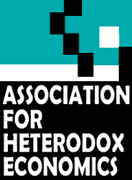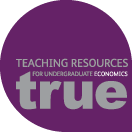2. The Heterodox module approach
A sample outline for a heterodox module, applicable to a number of levels, is shown in Table 2. In developing the module outline here, a higher level module is in mind but it is easily employed at level 1 when suitable adjustments are made for background, technical competence and maturity.
Table 2: Heterodox intermediate microeconomics module
|
Topic |
Detail |
|---|---|
|
What is heterodoxy? |
Single unified approach or plurality of approaches? |
|
Theories in microeconomics |
What is a theory and what makes it good? |
|
Key concepts in heterodoxy |
Should microeconomics exist? Individualism or social? Class and power. Systems versus atoms. Uncertainty. Equilibrium |
|
Theories of individual behaviour in consumption |
Behavioural and institutional theory; conception of ‘economic man’; Veblen, Galbraith; Figure 7: Biscuit experiment; Figure 8: Media watching |
|
Households as consumption and production units |
Marx; institutionalists; feminist theory |
|
Firms |
Why do firms exist? Responses to uncertainty (Galbraith); more effective exploitation (Marxists) |
|
Firms as production units |
Exploitation; Marx; Sraffa; modern Marxists; ecological implications; Figure 5: paper aeroplanes |
|
Firms and pricing |
Post-Keynesian theories; evidence on pricing and costs |
|
Competition and markets |
Classical/Marxian ‘globules of capital’ approach; Post-Keynesian monopoly capital approach; Austrian theory |
|
Markets |
Institutional approaches. ‘Real markets’. Keynesian beauty contest. Markets as failing mechanisms. Capital markets and efficiency. How markets and ecology interact. Figure 3: Kemp/Wunder game |
|
Government policy |
Rationale? Income distribution. Ecological issues. |
Immediately, that approach raises the concept of pluralism, which in Figure 1 was offered as a key tenet of heterodoxy. Thus heterodoxy advocates a range of perspectives and does not require that they are consistent. This is an interesting claim in itself. What do students think of it? What do their responses to that question tell us? Thereafter, the focus is on substantive areas. Space precludes a full discussion of these but an exercise discussed in Figure 5 allows us to see the heterodox approach in action. This example is one which could be used in an orthodox-plus module, a contending perspectives module or a heterodox module.
Figure 5: Production of paper aeroplanes
A useful exercise – which needs to occur in seminars – is to ask students to design a simple product and then its production process. A good example is a paper aeroplane (see Rubin, 2002). Students could form groups – or firms – and be invited to compete with each other on how much to produce. This is an interactive tool that students find enjoyable.
Several lessons can be learned from the activity, such as the connection between design complexity and productive complexity, and the possible trade-off between complexity and productive volume. In this sense, the paper aeroplane exercise is richer than moving flowerpots or tennis balls. Different students will choose different production methods: some will opt for individuals making entire aeroplanes; or teams; or production lines. If the exercise is done in stages – for example by gradually increasing the number of people involved in the production process – students can reflect on past performance, learn, and make judgements about what is effective.
In many cases, students will change their production methods. The results from the different rounds of production, with different amounts of labour employed, could easily be used to discuss marginal productivity (and whether it diminishes) and economies of scale. That could then lead to the theory of diminishing marginal productivity and of the U-shaped average cost curve. Equally, though, the results could suggest that diminishing marginal returns fail to occur; similarly, diseconomies may not occur.
All of the outcomes described in Figure 5 could be achieved on any module. Indeed, the exercise could be employed on a standard introductory microeconomics module. What is the heterodox value-added? Actually, the exercise illustrates several of the heterodox principles discussed in Figure 1. What if the game produces cost curves that do not form nice U-shapes and instead exhibit economies but not diseconomies of scale? That illustrates a theoretical point but also principle 4, on the unpredictability of economic cases. It also illustrates principle 6 on the fallibility of theories. Further, if different groups produce different results, principle 5 is illustrated: that history and time are important in determining economic outcomes.
In terms of theory, a finding of continuous economies of scale allows the L-shaped average cost curve to then be introduced. That curve has implications for the firm – for instance, it does not have an optimal size and is limited only by the amount it can sell (as Adam Smith noted). The L-shaped cost curve also has effects on pricing. There is a wealth of empirical literature on economies of scale and on the processes by which firms set prices. It is easy to go from the simple example of a paper aeroplane production process into discussion of heterodox pricing theories, such as Andrews’ normal cost theory and Means’ administered prices. Both of these theories are based on distinct theories of production and industrial organisation. This opens up new avenues for the students. The story of Hall and Hitch and their investigations into pricing offer an interesting case study of real research and an example of the case study method in economics. That illustrates heterodox principle 1, on the importance of methodological understanding.
Heterodox principle 5 stresses the importance of the history of economic thought. The paper aeroplanes exercise allows historical references to be made. One example is Smith’s discussion of the division of labour. For example, by examining and reflecting on the data the students have produced, one is led to examine concepts such as the division of labour. To what extent did students engage in specialisation, or did they manufacture complete aeroplanes? What are the implications for the level of production, the firm and – reflecting Smith’s own concern – the workers within the division of labour? Do the students prefer to see individually fulfilled workers, or the highest production possible?
The question of the ethics of the firm is then relevant. That reflects heterodox principle 9 in Figure 1: facts and values are inseparable. While that topic cannot be discussed in great depth it is another hallmark of a heterodox approach that questions of value are not banished to a normative box. For instance, can we say what a worker ought to receive from labour? Veblen, for one, says we cannot, except that such questions have social contexts. Marx, on the other hand, argued that workers should receive the fruits of their labours and that when they did not, they were being exploited. Do students agree? What is the potential for exploitation in the production processes they have designed? The Marxist account of Bowles and Gintis (1985) argues that production can be increased simply by increasing monitoring and, thereby, effort levels. Were the students producing more aeroplanes because their production methods were more efficient, or were they simply being forced to work harder? That discussion highlights heterodox principle 10, on the importance of power in economics.
There are several ways to run heterodox modules. One way is to discuss a specific paradigm. An example of this approach is discussed in Figure 6.
Figure 6: A feminist module on globalisation
Warnecke (2009) describes a module on gender and globalisation taught at Rollins College. One aspect of a feminist teaching strategy is to highlight gendered aspects of a phenomenon; hence the module examined topics such as international trade, migration and job security, with greater focus on how these things affected different genders in different ways. Further, the module deployed several pedagogical aspects as discussed in section 1.1.2 of the handbook chapter. For instance, Warnecke left open the topics of three class discussions late in the module and allowed students to propose topics on anything connecting gender and globalisation.
Additionally, throughout the module, each topic was considered using different perspectives. These two aspects were challenging for both the students and the instructor. Warnecke explains how she prepared the ground for both the discussions of gender and the deployment of different perspectives: this is crucial for success of such an approach. Overall the module received very good feedback about its content and the process of learning.
There are other examples of single paradigm modules, particularly on Institutionalism, in the USA. Such modules tend to have specific characteristics:
- Methodology underpins the institutionalist theory. John Dewey, for example, was a pragmatist philosopher on whom institutionalists draw extensively. Dewey embraced a dialectical method. Similarly, Veblen and others stressed key distinctions in the economy, their maintenance, effects and their breakdown. Other key methodological tenets are the stress on systems, evolution and change, valuation, and the complex nature of the individual. These concepts can then be applied to theoretical issues. A commonly chosen issue is the analysis of work, as developed in particular by Juliet Schor.
- Material from other disciplines, such as social psychology, is crucial. Students on these institutionalist modules are encouraged to read other disciplines’, which is useful for a discussion of human nature, a common feature of institutionalist modules.
- A historical approach is adopted, usually involving a historical account of economic development, in chronological order, beginning with pre-modern, through modern, on to contemporary economies dominated by large corporations. As institutionalist modules, they focus on the development of institutions over time. Also, their definition of institution is typical of the tradition, being much broader than simply defining an institution as a corporate body; rather, an institution includes habits of thought and of mind.
- Many courses also involve the integration of ecological concerns into the economics syllabus.
Other angles to take are:
- Political economy: Mavroudeas (2013) describes a first year module at the University of Macedonia, Greece, on political economy with a focus on Marxism. The course aims at providing an understanding of the economy. Consistent with the discussion in section 1.1.1 of the handbook chapter, the module combines the history of economics and of economies with methodological discussion. The module is in three parts, the first two setting the context for the main section of the module on Marxist political economy. The main concern therein is value, and how the nature of value affects capitalist accumulation and reproduction. The module addresses key theoretical debates in Marxism such as the so-called ‘transformation problem’, but roots all of these in discussion of contemporary reality.
- A module in Comparative Economic Thought at Galway offers a different way to deliver a heterodox module. The module begins with a brief critical presentation of the neoclassical approach, and then proceeds into a series of alternatives, including Post-Keynesian, Cambridge, Marxian and Institutionalist. There is no attempt here to offer a single, unified heterodox approach. Rather, the different schools of thought are offered individually and students are invited to compare them. In this module the emphasis is on literature and on critique. The comparative analysis involved is clear, not least from the title of the module.
- A single coherent heterodox approach: Goodwin and Harris (2001) present a heterodox microeconomics module, based on a microeconomics text called Microeconomics in Context. They advocate a new paradigm: contextual economics, which combines elements of ecological, feminist, institutionalist, Marxist, radical, and even (reconfigured) neoclassical economics which attempts to synthesise elements of those parts. Their position is that orthodox micro systematically ignores issues of context, particularly ecological issues (a common complaint). When the text presents standard microeconomic concepts, they are always positioned in the relevant contexts. Thus, the module structure focuses on a series of topics: the relationship between wealth, consumption, well-being and ecological balance; historical perspectives on capitalism; markets, industrialisation and culture; household labour and child rearing; trends in corporate growth and market power; wage differentials and income inequality; and environmental externalities and intergenerational equity.
Section 3 of the handbook chapter considers the advantages and opportunities of a heterodox module.



